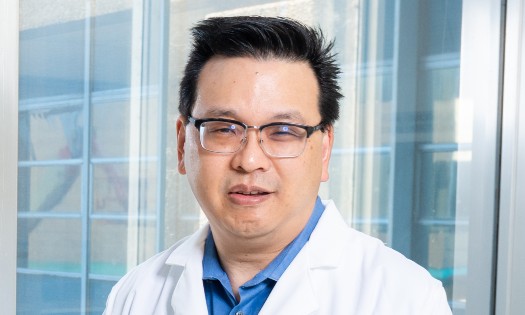In July, 2020, a 16-year-old male came to the Claude Prestidge Cystic Fibrosis Center at Children’s Health℠ with an ongoing problem: a persistent cough that was interfering with his ability to play baseball and engage in other activities he loved.
“The cough was really impacting his daily life. We had a virtual visit with him and he told us, ‘I just can't get a break. I wake up and I cough, and then I cough all day long’,” says Preeti Sharma, M.D., a Pediatric Pulmonologist at Children’s Health and an Associate Professor at UT Southwestern.
Dr. Sharma co-directs our cystic fibrosis (CF) center with Meghana Sathe, M.D., a Pediatric Gastroenterologist at Children’s Health and an Associate Professor at UT Southwestern – a rare arrangement where experts in two key specialties co-lead a CF center.
To treat the teen, Dr. Sathe and Dr. Sharma followed the center’s multidisciplinary approach, collaborating with each other and with other specialists. They probed for the cause of the cough and worked with the patient and his family to develop a treatment plan that included the breakthrough CF drug Trikafta. When his cough persisted, the care team worked to figure out what else might be contributing, pursued treatments that included sinus and reflux surgery, and eventually got the cough under control.
“It shows how we constantly bring together different specialties and trade ideas until we find an effective treatment plan,” says Dr. Sathe. “We see patients together and hear about the same symptoms at the same time. The combined effort – and partnering with patients and families – leads to a better understanding of what's causing the symptoms and to better outcomes.”
Putting together a comprehensive picture
CF is a rare, genetic disease that causes thick, sticky mucus to build up in different organs. It can affect the lungs, digestive tract, the male genitourinary tract and the skin.
CF can slow a child’s growth by making it harder to digest food, and the mucus can trigger repeated infections that damage airways and lungs. As a progressive disease, it can also shorten life expectancy.
To help children manage CF, the center brings together respiratory and GI experts as well as psychologists, nutritionists, respiratory therapists and endocrinologists. The team uses their varied expertise to create a comprehensive picture of a patient’s health so that they can understand – and treat – the entire patient. With CF, that collaborative approach is critical.
“One of the care goals is to maximize lung function and prevent its decline,” says Dr. Sharma. “Our clinic team works aggressively on nutrition and growth, which drive the stability of lung function, especially for babies and young children. This focus has very much improved our pulmonary function outcomes.”
Trying a breakthrough therapy
Although newborns across Texas have been screened for cystic fibrosis since 2010, this teen was not diagnosed until age two months since he was born before universal screening started.
“His ethnicity may have also played a role in delayed diagnosis,” says Dr. Sathe. “His mother is of Caucasian descent and his father is of South Asian descent. CF is thought to be more predominant in Caucasians, so the pediatricians might not have looked for it.”
Until the cough started, he generally had good lung function, but he did face challenges with nutrition and slower growth.
“He had a G-tube placed when he was a toddler due to poor weight gain, feeding problems and severe reflux,” says Dr. Sathe. “He has worked with the dietitian and me over the years to manage his nutrition. He’s an active kid, and improving his nutritional status has helped him be able to play baseball, which he loves.”
In 2019, a new option became available for CF patients when the FDA approved the novel CF treatment Trikafta. The drug is the first to treat the causes of the disease – the defective CFTR protein – rather than just the symptoms. Trikafta has been shown to help some CF patients gain weight and improve lung function by up to 10 to 15%. There’s also strong evidence that Trikafta can break the cycle of chronic infection, inflammation and lung damage in some patients, which can significantly extend lifespan.
“The family was excited about the new drug and was excited to try it,” says Dr. Sathe.
Tackling a persistent cough
When the teen started taking Trikafta, his symptoms did not improve as expected. The care team had changed his reflux medications, which had interacted with Trikafta. The reflux got worse, as did the cough, and his lung function started to decline.
This young man and his family had always been adherent to his CF regimen, but this time the breathing treatments and chest physiotherapy he used to clear mucus from his lungs did not help.
“He is a savvy young man who knew that with increased mucus in his lungs, he should increase his airway clearance even before he saw us,” says Dr. Sharma. “But the cough persisted.”
The team treated him with antibiotics, sometimes intravenously. He was hospitalized repeatedly.
“We brought the entire team together to solve the puzzle of this cough,” says Dr. Sathe. “We worked together as a multidisciplinary team and partnered with the family to look at all possible angles.”
An ENT physician identified that sinus disease was contributing to the cough. The patient had sinus surgery, which relieved some symptoms, but he continued to have disruptive coughing episodes.
Eventually, the care team realized that significant reflux was also a major factor in the teen’s cough. He had reflux surgery, which was successful in decreasing the reflux symptoms.
“He is still struggling with some other pulmonary aspects of CF – bacteria that are challenging to treat,” says Dr. Sharma, “but they’re unrelated to reflux or gastrointestinal issues. And he doesn’t have that debilitating cough any longer.”
How team care improves outcomes
Collaboration made a big difference.
When a colleague performed the sinus surgery, Dr. Sharma did a bronchoscopy to look for untreated bacterial pathogens, and an impedance probe to evaluate for reflux was placed. Meeting with the patient together enabled Drs. Sharma and Sathe to realize that reflux might be playing a role and allowed them to perform all procedures needed for evaluation during one anesthesia event.
“Working together, we were both able to ask questions that helped us understand the picture better,” says Sathe. “I might ask, ‘When does the cough occur?’ She'd say, ‘I wonder if there is a bad taste in the mouth when he coughs.’”
“When we talk openly about what approach to take,” says Dr. Sathe, “our patients and families feel part of the decision – and they see that we’re thinking about an individual patient and not just following an algorithm.”
For the physicians, this case is more proof that the best outcomes are achieved when a team of experts works together to take care of complex patients.
“With a pediatric gastroenterologist who is a CF expert working closely at my side, I know I'm not missing things in regards to the GI aspects of CF,” says Dr. Sharma. “Teamwork and collaborative care should be the model for any multisystem chronic illness.”
Learn more about the latest research and advances at Children’s Health.


